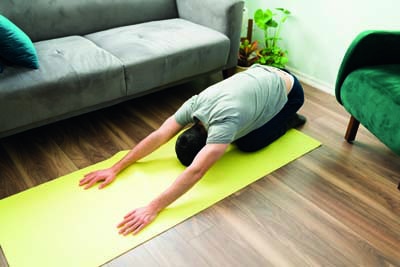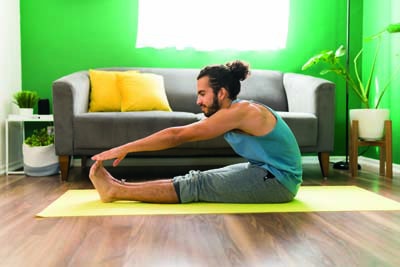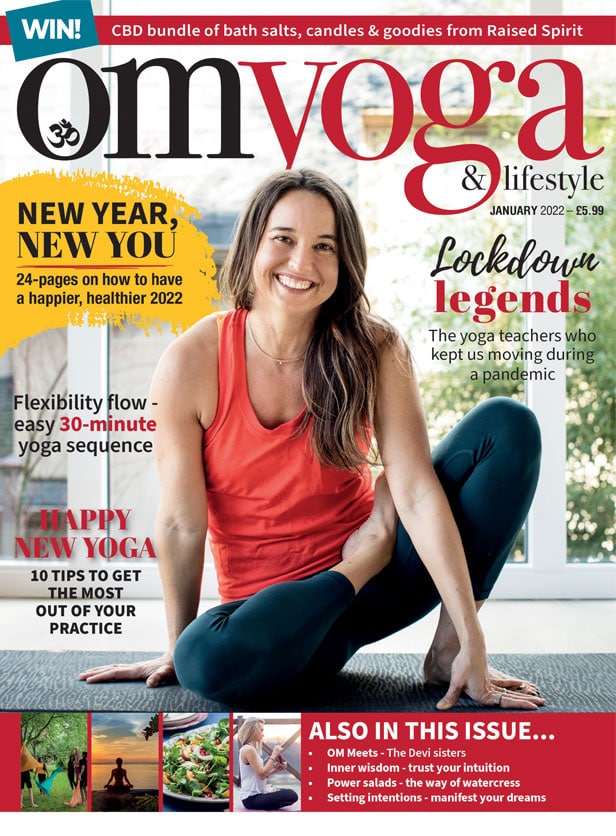
Yoga for remote workers
Tools to manage anxiety for the remote worker. By Kyle Michaud
Right now, we are living in a different time, where people are turning to remote work-life rather than in-office. This of course comes with many perks, like getting to be with family and avoiding the anxiety-inducing commute. But it also has its drawbacks. Remote workers need to learn how to separate their lives from their work – even though they now exist in the same physical space. People love working remotely because it allows for a more flexible schedule and saves time (and money) typically spent commuting. A study conducted by Upwork estimates that by 2025, 36.2 million Americans will be remote, an increase of 16.8 million people from pre-pandemic rates, proving that working from home is becoming a new normal.
But in-office work allows you more time to socialise and separate yourself from your to-do list. Working from home can foster feelings of solitude, as well as worry and anxiety. In Buffer’s 2021 State of Remote Work survey, 27% of respondents felt like their biggest work-from-home struggle was not being able to unplug – which can negatively impact your mental and physical health if you do not have the proper techniques to find and maintain balance.
Incorporating simple yoga practices into your everyday work-from-home routine will equip you with mental and physical tools you need to help manage anxiety and stress. Just five minutes in the morning or interspersed throughout your day can bring a much-needed mental respite to your hectic work life. Practicing yoga regularly provides a new sense of clarity and helps sharpen your concentration, which not only improves your overall mental health, but also your work performance.
Studies have shown that yoga can be considered as a complementary therapy or an alternative method for medical therapy in treating anxiety disorders. Some anxiety triggers that come with working from home are lack of personal contact and difficulties communicating and collaborating with co-workers remotely. If you’re a person who is looking for holistic ways to combat anxiety, follow these steps to re-centre yourself and find your balance.
Mindfulness
Mindfulness allows you to look inward and reflect on your personal needs and desires. Looking in to understand and give yourself the gratitude you deserve is important to overcome the thoughts that consume you when working from home: Am I doing enough? Is my job in jeopardy? Is my manager seeing the value that I bring to the team?
It is important to wake up every morning and set intentions for yourself. Ask yourself questions instead that will help propel you to achieve your daily goals. For example: How can I improve my communication with my coworkers? How am I going to strengthen my capabilities? What do I need to do today to be successful?
Breathing exercises
Deep breathing patterns are important techniques to use when trying to overcome stresses caused by work and can help realign yourself and your intentions.
When you feel stress or anxiety, our body’s natural response is to take short, rapid breaths, also known as thoracic breathing. When you find yourself in this mindset, the type of breathing you want to imitate is diaphragmatic breathing – or deep, belly breathing. This breathing pattern helps you to relax and lowers the harmful effects that the stress hormone, cortisol, can have on your body.
To practice this, find an environment that is calm and quiet with no distractions. Sit or lie down in a position that is most comfortable to you, then – with your eyes closed – place one hand on your chest, and the other on your belly.
Next, make sure all the muscles in your body are completely relaxed, breathe in through your nose without raising your chest or shoulders, feel your belly rise with your hand and then exhale slowly through pursed lips as your hand and belly return to their original position. Repeat this practice as many times as you want for about 5-10 minutes at a time to help reduce anxiety and increase focus in your day.
Beginner yoga poses
Traditional yoga poses can also help improve your mental health. My favourite poses that help clear my mind and manage my anxiety are the following:
Child’s Pose: This pose is great for relieving stress and fatigue. It is also simple and very low impact, so it’s good for yogis at any level.

Seated Forward Bend: This pose is meant to relax your mind and reduce anxiety. I also find it great for reflection. When my mind is racing with the stresses of everyday life, this lets me take a step back and refocus my intentions.

Leg-up-the-wall Pose: This is a slightly more challenging pose with a deeper stretch. It’s always good to challenge yourself with new yoga poses to help you gain the confidence you need to overcome challenges you encounter in life or at work.
Incorporating mindfulness, conscious breathing exercises, and some easy yoga poses into your day-to-day routine will help you clear your mind and relax before, during and after stressful days at work. It will give you a reason to unplug, re-centre yourself and reframe your perspective so you can confidently conquer the challenges you face in your everyday life.
Kyle Michaud is the founder and creator of the plant-based consumer festival company, Experience Expositions (experienceexpos.com)




